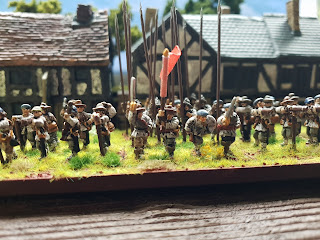Marquis of Newcastle's Regiment of Foot
The latest Royalist regiment of foot to come off the painting table gets a special post all to itself. Why? Marquis of Newcastle's whitecoats are a bit special, even if they are Royalist.
Plus what's not to like about having a Colonel called Posthumous Kirton? Newcastle having a second wife who was known as 'Mad Madge of Newcastle' being the clincher.
In 1642 the Marquis bought 3000 Scots "blew bonnets" to equip his regiments of foot, so this necessitated more than a few head swaps. Apparently Newcastle wanted red coats, but the soldiers wanted white - promising to dye them red with the blood of the enemy.
At Marston Moor, they famously made an heroic last stand (we'll gloss over the fact that they arrived late as they were looting the Parliamentarian defensive positions around York). Refusing to surrender, they resisted repeated charges by the Parliamentarian cavalry until no more than 30 were left alive. This famous last stand was probably a rear guard action to cover the surviving Royalist infantry as they retreated to York.
William Cavendish was an interesting fellow, friendly with King Charles and Queen Henrietta Maria. he was entrusted with the education of the Prince of Wales (later Charles II) and was known as a playwright, and for his riding skills. He went into self-imposed exile after Marston Moor, living in the Rubenshuis in Antwerp until he returned to England with the Restoration; whereby he was promoted from Marquess of Newcastle to Duke of Newcastle. He died aged 84, and is buried in Westminster Abbey.
For a potted history of the regiment try this article on the Newcastle's Regiment (Sealed Knot) website. Their website has lots of pictures, great for painting inspiration.
White coated figures are one of the hardest colour schemes to get right (just ask anyone who has painted a Napoleonic Austrian army). I test painted a few figures white then washed one with Nuln Oil, one with Agrax Earthshade and one with Seraphim Sepia. The brown washes made the figures look yellowy brown which just didn't look right, the Nuln Oil giving a more pleasing effect.
So I eventually went the simple route here - spray painted Army Painter white, blocked in other colours then a wash with Citadel Nuln Oil.
Plus what's not to like about having a Colonel called Posthumous Kirton? Newcastle having a second wife who was known as 'Mad Madge of Newcastle' being the clincher.
In 1642 the Marquis bought 3000 Scots "blew bonnets" to equip his regiments of foot, so this necessitated more than a few head swaps. Apparently Newcastle wanted red coats, but the soldiers wanted white - promising to dye them red with the blood of the enemy.
At Marston Moor, they famously made an heroic last stand (we'll gloss over the fact that they arrived late as they were looting the Parliamentarian defensive positions around York). Refusing to surrender, they resisted repeated charges by the Parliamentarian cavalry until no more than 30 were left alive. This famous last stand was probably a rear guard action to cover the surviving Royalist infantry as they retreated to York.
William Cavendish was an interesting fellow, friendly with King Charles and Queen Henrietta Maria. he was entrusted with the education of the Prince of Wales (later Charles II) and was known as a playwright, and for his riding skills. He went into self-imposed exile after Marston Moor, living in the Rubenshuis in Antwerp until he returned to England with the Restoration; whereby he was promoted from Marquess of Newcastle to Duke of Newcastle. He died aged 84, and is buried in Westminster Abbey.
For a potted history of the regiment try this article on the Newcastle's Regiment (Sealed Knot) website. Their website has lots of pictures, great for painting inspiration.
White coated figures are one of the hardest colour schemes to get right (just ask anyone who has painted a Napoleonic Austrian army). I test painted a few figures white then washed one with Nuln Oil, one with Agrax Earthshade and one with Seraphim Sepia. The brown washes made the figures look yellowy brown which just didn't look right, the Nuln Oil giving a more pleasing effect.
So I eventually went the simple route here - spray painted Army Painter white, blocked in other colours then a wash with Citadel Nuln Oil.
If you enjoyed reading this, or any of the other posts, please consider supporting the blog.
Thanks.













Comments
Post a Comment